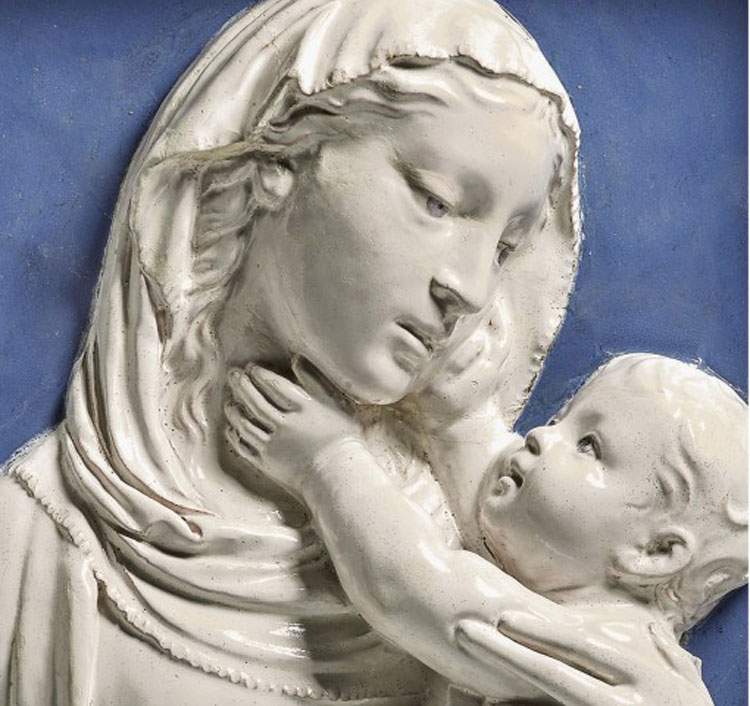The Madonna of Santa Fiora, a splendid glazed terracotta dated between 1440 and 1450 and attributed to Luca della Robbia, will go up for auction at Sotheby’s in New York on January 28, with an estimated sale value of between $700,000 and $1 million.
In this regard, the Municipality of Santa Fiora (Grosseto) is launching an appeal to patrons, Foundations, Banking Institutions, the Region and MiBACT to purchase this extraordinary masterpiece and bring it back to its territory of origin, since the collection of Della Robbia ceramics in Santa Fiora is one of the most significant in the world.
It is a glazed terracotta relief with white figures on a turquoise background, which features a glazed frame in white, blue stripes and discs in imitation of a precious marble inlay.
The Madonna of Santa Fiora was commissioned by the Sforza family of Santa Fiora, probably Count Bosio I to Luca della Robbia, and remained in the Amiata village for more than four hundred years, until, following the suppression of religious orders in July 1866, the property was confiscated by the municipality and sold in 1867 to Léon Mathieu Henri de Somzée, a mining engineer, wealthy financier, parliamentarian and art collector. The hypothesis is that de Somzée had come into contact with this Della Robbia terracotta during the time he was working in Italy. According to a 1904 catalog, the work may originally have been destined for the church of Santa Chiara in Santa Fiora.
The masterpiece then left the village in 1867 to become part of Somzèe’s private collection in Brussels. The widow de Somzèe sold it before 1913 to Rudolph Bottenwieser; it later passed to Paul Bottenwieser, a Berlin art dealer working in New York for the Anderson Gallerie Building on Park Avenue, the Madonna and Child of Santa Fiora reached the United States and was sold in 1929 to its current owner: the Albright Art Gallery in Buffalo, which became the Albright-Knox Art Gallery in 1962.
“It would be extraordinary for Santa Fiora to bring back this beautiful piece that would become a central element of our Robbiane collection,” commented Mayor Federico Balocchi. “We are willing to do our part and allocate resources, but the price is prohibitive for our municipality. That’s why we are launching an appeal to entrepreneurs or collectors so that they can buy the work and in the meantime at least bring it back to Italy. After that, by seeking the support of Foundations, banking institutions and private citizens, we could start a path for it to return to Santa Fiora. We also launch an appeal to the Minister of Culture to do everything in his power to be able to bring the Madonna back to Italian territory, possibly to Santa Fiora. The work could be placed inside the Museum of Palazzo Sforza, where the precious private collection of paintings and historical documents that Francesco Sforza Cesarini gave to the municipality on loan for use for the next fifteen years will also be kept. Santa Fiora was for centuries the Capital of a County,” he continues, "and today we can recount this illustrious past, thanks to the concrete and far-sighted projects put in place by the Municipality to enhance and enrich the extraordinary historical and artistic heritage of our small village. Certainly to see that the Madonna of Santa Fiora is being sold in New York at such an important price on the one hand pains us, but on the other makes us proud of the artistic heritage that is left with us and that we must increasingly enhance."
The robbiane currently in Santa Fiora are attributed to Andrea della Robbia, Luca’s grandson, who made these works on commission from Count Guido Sforza, lord of Santa Fiora, to decorate the family’s private chapel. In the Pieve di Santa Fiora one can admire the Baptism of Jesus, the Madonna of the Girdle, the Last Supper with the Ascension of Jesus into Heaven and the Resurrection, a triptych depicting the Coronation of the Virgin and Saints Francis and Jerome. A crucifix and a tabernacle of the holy oils complete the cycle of works. Another Della Robbia ceramic, depicting Saints Flora and Lucilla, can be found on the entrance façade of the church of the Madonna delle Nevi in the Montecatino terziere, also known as the church of Pescina, and also on the tower clock a glazed Della Robbia ceramic is clearly visible, a surviving element of the original ancient clock.
Pictured is a detail of the Madonna of Santa Fiora by Luca della Robbia.
 |
| Bringing home the Madonna of Santa Fiora. Up for auction in New York, municipality appeals |
Warning: the translation into English of the original Italian article was created using automatic tools. We undertake to review all articles, but we do not guarantee the total absence of inaccuracies in the translation due to the program. You can find the original by clicking on the ITA button. If you find any mistake,please contact us.